Easy-to-Print PLA 3D Printer Filaments
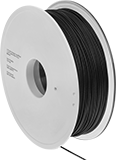 | Black | Blue | Gray | Green | Orange | Red | White | Yellow | Clear | ||
Bronze | Gold | Beige | Glow-in-the-Dark Blue | Glow-in-the-Dark Green | Glow-in-the-Dark Orange | ||||||
The most commonly used 3D printing material, these PLA filaments make detailed parts at a low melting point, so they won’t warp as they cool, rarely clog nozzles, and don’t require a heated printer bed. They’re also unlikely to drip and produce plastic strings for a clean finished part. In general, they’re best for printing prototypes instead of load-bearing parts since they’re not as strong as ABS or as heat resistant as PEEK. Print them on a fused filament fabrication (FFF) 3D printer.
Carbon fiber-filled PLA filaments make rigid parts that are difficult to bend and break. Their parts can also be threaded and machined more easily than the same non-filled filaments. Because these filaments are abrasive, you should only use them with abrasion-resistant nozzles.
Stainless steel-, iron-, copper-, and brass-filled PLA filaments are heavier and transfer heat better than plastic-only filaments. Brush, sand, or polish printed parts for a metallic finish. Stainless steel and iron are abrasive, so use them with abrasion-resistant nozzles only. Iron will also rust if exposed to water.
Wood-like PLA filaments mimic wood without actual wood powder, and exhibit similar density and appearance to wood. You can sand, paint, and stain your part.
Static-dissipative PLA filaments make parts that protect equipment from electrostatic shocks by diverting electrostatic discharges in a controlled way. They’re often used to create tool handles, tote trays, enclosures, and other parts that are used near sensitive electronics. To adjust the surface resistivity of your printed part, change the temperature of your printer’s extruder. As the extruder’s temperature increases, the printed part’s resistivity will decrease.
Conductive PLA filaments are best for creating circuit prototypes and other conductive pathways. To adjust the surface resistivity of your printed part, change the temperature of your printer’s extruder. As the extruder’s temperature increases, the printed part’s resistivity will decrease.
Expose parts made with glow-in-the-dark PLA filaments to ambient light and they will stay visible in the dark. Use these filaments to create machine switches and handles or custom signs and labels that can be seen in low-light conditions. Because they’re abrasive, you should only use them with abrasion-resistant nozzles.
Filaments with an annealing temperature can be heat treated to make parts harder, stronger, and better at resisting heat. To anneal, heat your finished part to the listed temperature and then let it cool slowly.
Tensile strength is the best measure of a filament’s overall strength. Similar to the stress applied on a rope during a game of tug-of-war, it’s the amount of pulling force a material can handle before breaking. A higher rating means a stronger filament. A tensile strength of 5,000 psi and above is considered good; 12,000 psi and above is excellent.
Maximum exposure temperature is the point at which a printed part will begin to deform. Above this temperature, your part will start to lose structural integrity. Filaments that can be annealed are also rated for maximum temperature after annealing, which is the new maximum exposure temperature once that process completes.
Spool | Each | ||||||||||||
|---|---|---|---|---|---|---|---|---|---|---|---|---|---|
| Dia., mm | Printing Temp. | For Printer Bed Temp. | Tensile Strength | Max. Exposure Temp. | Annealing Temp. | Max. Temp. After Annealing | For Min. Nozzle Dia., mm | Dia., mm | Dp., mm | Wt., g | 1-9 | 10-Up | |
PLA Plastic | |||||||||||||
Opaque Black | |||||||||||||
| 1.75 | 190° to 220° C 374° to 428° F | 25° to 60° C 77° to 140° F | 3,840 psi (Poor) | 59° C 138° F | __ | __ | 0.4 | 200 | 65 | 1,000 | 00000000 | 000000 | 000000 |
| 1.75 | 190° to 230° C 374° to 446° F | 0° to 70° C 32° to 158° F | 9,500 psi (Good) | 60° C 140° F | 110° to 120° C 230° to 248° F | 130° C 266° F | 0.4 | 200 | 91 | 1,000 | 00000000 | 00000 | 00000 |
| 2.85 | 190° to 230° C 374° to 446° F | 0° to 70° C 32° to 158° F | 9,500 psi (Good) | 60° C 140° F | 110° to 120° C 230° to 248° F | 130° C 266° F | 0.4 | 200 | 91 | 1,000 | 00000000 | 00000 | 00000 |
Opaque Blue | |||||||||||||
| 1.75 | 190° to 220° C 374° to 428° F | 25° to 60° C 77° to 140° F | 3,840 psi (Poor) | 59° C 138° F | __ | __ | 0.4 | 200 | 65 | 1,000 | 00000000 | 00000 | 00000 |
| 1.75 | 190° to 230° C 374° to 446° F | 0° to 70° C 32° to 158° F | 9,500 psi (Good) | 60° C 140° F | 110° to 120° C 230° to 248° F | 130° C 266° F | 0.4 | 200 | 91 | 1,000 | 00000000 | 00000 | 00000 |
| 2.85 | 190° to 230° C 374° to 446° F | 0° to 70° C 32° to 158° F | 9,500 psi (Good) | 60° C 140° F | 110° to 120° C 230° to 248° F | 130° C 266° F | 0.4 | 200 | 91 | 1,000 | 00000000 | 00000 | 00000 |
Opaque Gray | |||||||||||||
| 1.75 | 190° to 220° C 374° to 428° F | 25° to 60° C 77° to 140° F | 3,840 psi (Poor) | 59° C 138° F | __ | __ | 0.4 | 200 | 65 | 1,000 | 00000000 | 00000 | 00000 |
| 1.75 | 190° to 230° C 374° to 446° F | 0° to 70° C 32° to 158° F | 9,500 psi (Good) | 60° C 140° F | 110° to 120° C 230° to 248° F | 130° C 266° F | 0.4 | 200 | 91 | 1,000 | 00000000 | 00000 | 00000 |
| 2.85 | 190° to 230° C 374° to 446° F | 0° to 70° C 32° to 158° F | 9,500 psi (Good) | 60° C 140° F | 110° to 120° C 230° to 248° F | 130° C 266° F | 0.4 | 200 | 91 | 1,000 | 00000000 | 00000 | 00000 |
Opaque Green | |||||||||||||
| 1.75 | 190° to 220° C 374° to 428° F | 25° to 60° C 77° to 140° F | 3,840 psi (Poor) | 59° C 138° F | __ | __ | 0.4 | 200 | 65 | 1,000 | 00000000 | 00000 | 00000 |
| 1.75 | 190° to 230° C 374° to 446° F | 0° to 70° C 32° to 158° F | 9,500 psi (Good) | 60° C 140° F | 110° to 120° C 230° to 248° F | 130° C 266° F | 0.4 | 200 | 91 | 1,000 | 00000000 | 00000 | 00000 |
| 2.85 | 190° to 230° C 374° to 446° F | 0° to 70° C 32° to 158° F | 9,500 psi (Good) | 60° C 140° F | 110° to 120° C 230° to 248° F | 130° C 266° F | 0.4 | 200 | 91 | 1,000 | 00000000 | 00000 | 00000 |
Opaque Orange | |||||||||||||
| 1.75 | 190° to 220° C 374° to 428° F | 25° to 60° C 77° to 140° F | 3,840 psi (Poor) | 59° C 138° F | __ | __ | 0.4 | 200 | 65 | 1,000 | 00000000 | 00000 | 00000 |
| 1.75 | 190° to 230° C 374° to 446° F | 0° to 70° C 32° to 158° F | 9,500 psi (Good) | 60° C 140° F | 110° to 120° C 230° to 248° F | 130° C 266° F | 0.4 | 200 | 91 | 1,000 | 00000000 | 00000 | 00000 |
| 2.85 | 190° to 230° C 374° to 446° F | 0° to 70° C 32° to 158° F | 9,500 psi (Good) | 60° C 140° F | 110° to 120° C 230° to 248° F | 130° C 266° F | 0.4 | 200 | 91 | 1,000 | 00000000 | 00000 | 00000 |
Opaque Red | |||||||||||||
| 1.75 | 190° to 220° C 374° to 428° F | 25° to 60° C 77° to 140° F | 3,840 psi (Poor) | 59° C 138° F | __ | __ | 0.4 | 200 | 65 | 1,000 | 00000000 | 00000 | 00000 |
| 1.75 | 190° to 230° C 374° to 446° F | 0° to 70° C 32° to 158° F | 9,500 psi (Good) | 60° C 140° F | 110° to 120° C 230° to 248° F | 130° C 266° F | 0.4 | 200 | 91 | 1,000 | 00000000 | 00000 | 00000 |
| 2.85 | 190° to 230° C 374° to 446° F | 0° to 70° C 32° to 158° F | 9,500 psi (Good) | 60° C 140° F | 110° to 120° C 230° to 248° F | 130° C 266° F | 0.4 | 200 | 91 | 1,000 | 00000000 | 00000 | 00000 |
Opaque White | |||||||||||||
| 1.75 | 190° to 220° C 374° to 428° F | 25° to 60° C 77° to 140° F | 3,840 psi (Poor) | 59° C 138° F | __ | __ | 0.4 | 200 | 65 | 1,000 | 00000000 | 00000 | 00000 |
| 1.75 | 190° to 230° C 374° to 446° F | 0° to 70° C 32° to 158° F | 9,500 psi (Good) | 60° C 140° F | 110° to 120° C 230° to 248° F | 130° C 266° F | 0.4 | 200 | 91 | 1,000 | 00000000 | 00000 | 00000 |
| 2.85 | 190° to 230° C 374° to 446° F | 0° to 70° C 32° to 158° F | 9,500 psi (Good) | 60° C 140° F | 110° to 120° C 230° to 248° F | 130° C 266° F | 0.4 | 200 | 91 | 1,000 | 00000000 | 00000 | 00000 |
Opaque Yellow | |||||||||||||
| 1.75 | 190° to 220° C 374° to 428° F | 25° to 60° C 77° to 140° F | 3,840 psi (Poor) | 59° C 138° F | __ | __ | 0.4 | 200 | 65 | 1,000 | 00000000 | 00000 | 00000 |
| 1.75 | 190° to 230° C 374° to 446° F | 0° to 70° C 32° to 158° F | 9,500 psi (Good) | 60° C 140° F | 110° to 120° C 230° to 248° F | 130° C 266° F | 0.4 | 200 | 91 | 1,000 | 00000000 | 00000 | 00000 |
| 2.85 | 190° to 230° C 374° to 446° F | 0° to 70° C 32° to 158° F | 9,500 psi (Good) | 60° C 140° F | 110° to 120° C 230° to 248° F | 130° C 266° F | 0.4 | 200 | 91 | 1,000 | 00000000 | 00000 | 00000 |
Clear | |||||||||||||
| 1.75 | 195° to 225° C 383° to 437° F | 21° to 60° C 70° to 140° F | Not Rated | 60° C 140° F | 100° to 120° C 212° to 248° F | 155° C 311° F | 0.4 | 200 | 50 | 500 | 0000000 | 00000 | 00000 |
| 2.85 | 195° to 225° C 383° to 437° F | 21° to 60° C 70° to 140° F | Not Rated | 60° C 140° F | 100° to 120° C 212° to 248° F | 155° C 311° F | 0.4 | 200 | 50 | 500 | 0000000 | 00000 | 00000 |
Semi-Clear Gray | |||||||||||||
| 1.75 | 195° to 225° C 383° to 437° F | 21° to 60° C 70° to 140° F | Not Rated | 60° C 140° F | 100° to 120° C 212° to 248° F | 155° C 311° F | 0.4 | 200 | 50 | 500 | 0000000 | 00000 | 00000 |
| 2.85 | 195° to 225° C 383° to 437° F | 21° to 60° C 70° to 140° F | Not Rated | 60° C 140° F | 100° to 120° C 212° to 248° F | 155° C 311° F | 0.4 | 200 | 50 | 500 | 0000000 | 00000 | 00000 |
Carbon-Fiber-Filled PLA Plastic | |||||||||||||
Opaque Black | |||||||||||||
| 1.75 | 195° to 225° C 383° to 437° F | 21° to 60° C 70° to 140° F | Not Rated | 60° C 140° F | 100° to 120° C 212° to 248° F | 138° C 280° F | 0.4 | 200 | 50 | 500 | 0000000 | 00000 | 00000 |
| 1.75 | 195° to 225° C 383° to 437° F | 21° to 60° C 70° to 140° F | Not Rated | 60° C 140° F | 100° to 120° C 212° to 248° F | 138° C 280° F | 0.4 | 300 | 100 | 3,000 | 0000000 | 000000 | 000000 |
| 1.75 | 210° to 230° C 410° to 446° F | 21° to 60° C 70° to 140° F | Not Rated | 60° C 140° F | __ | __ | 0.4 | 200 | 50 | 500 | 0000000 | 00000 | 00000 |
| 1.75 | 210° to 230° C 410° to 446° F | 21° to 60° C 70° to 140° F | Not Rated | 60° C 140° F | __ | __ | 0.4 | 300 | 100 | 3,000 | 0000000 | 000000 | 000000 |
| 2.85 | 195° to 225° C 383° to 437° F | 21° to 60° C 70° to 140° F | Not Rated | 60° C 140° F | 100° to 120° C 212° to 248° F | 138° C 280° F | 0.4 | 200 | 50 | 500 | 0000000 | 00000 | 00000 |
| 2.85 | 195° to 225° C 383° to 437° F | 21° to 60° C 70° to 140° F | Not Rated | 60° C 140° F | 100° to 120° C 212° to 248° F | 138° C 280° F | 0.4 | 300 | 100 | 3,000 | 0000000 | 000000 | 000000 |
| 2.85 | 210° to 230° C 410° to 446° F | 21° to 60° C 70° to 140° F | Not Rated | 60° C 140° F | __ | __ | 0.4 | 200 | 50 | 500 | 0000000 | 00000 | 00000 |
| 2.85 | 210° to 230° C 410° to 446° F | 21° to 60° C 70° to 140° F | Not Rated | 60° C 140° F | __ | __ | 0.4 | 300 | 100 | 3,000 | 0000000 | 000000 | 000000 |
Stainless Steel-Filled PLA Plastic | |||||||||||||
Opaque Gray | |||||||||||||
| 1.75 | 210° to 230° C 410° to 446° F | 21° to 60° C 70° to 140° F | Not Rated | 60° C 140° F | __ | __ | 0.4 | 200 | 50 | 500 | 0000000 | 00000 | 00000 |
| 1.75 | 210° to 230° C 410° to 446° F | 21° to 60° C 70° to 140° F | Not Rated | 60° C 140° F | __ | __ | 0.4 | 300 | 100 | 2,000 | 0000000 | 000000 | 000000 |
| 2.85 | 210° to 230° C 410° to 446° F | 21° to 60° C 70° to 140° F | Not Rated | 60° C 140° F | __ | __ | 0.4 | 200 | 50 | 500 | 0000000 | 00000 | 00000 |
| 2.85 | 210° to 230° C 410° to 446° F | 21° to 60° C 70° to 140° F | Not Rated | 60° C 140° F | __ | __ | 0.4 | 300 | 100 | 2,000 | 0000000 | 000000 | 000000 |
Iron-Filled PLA Plastic | |||||||||||||
Opaque Gray | |||||||||||||
| 1.75 | 190° to 210° C 374° to 410° F | 21° to 60° C 70° to 140° F | Not Rated | 60° C 140° F | __ | __ | 0.4 | 200 | 50 | 500 | 0000000 | 00000 | 00000 |
| 1.75 | 190° to 210° C 374° to 410° F | 21° to 60° C 70° to 140° F | Not Rated | 60° C 140° F | __ | __ | 0.4 | 300 | 100 | 2,000 | 0000000 | 000000 | 000000 |
| 2.85 | 190° to 210° C 374° to 410° F | 21° to 60° C 70° to 140° F | Not Rated | 60° C 140° F | __ | __ | 0.4 | 200 | 50 | 500 | 0000000 | 00000 | 00000 |
Copper-Filled PLA Plastic | |||||||||||||
Opaque Bronze | |||||||||||||
| 1.75 | 185° to 215° C 365° to 419° F | 21° to 60° C 70° to 140° F | Not Rated | 60° C 140° F | 100° to 120° C 212° to 248° F | 155° C 311° F | 0.4 | 200 | 65 | 500 | 0000000 | 00000 | 00000 |
Brass-Filled PLA Plastic | |||||||||||||
Opaque Gold | |||||||||||||
| 1.75 | 185° to 215° C 365° to 419° F | 21° to 60° C 70° to 140° F | Not Rated | 60° C 140° F | 100° to 120° C 212° to 248° F | 155° C 311° F | 0.4 | 200 | 65 | 500 | 0000000 | 00000 | 00000 |
Wood-Like PLA Plastic | |||||||||||||
Opaque Beige | |||||||||||||
| 1.75 | 190° to 210° C 374° to 410° F | 30° to 50° C 86° to 122° F | 3,490 psi (Poor) | 58° C 136° F | __ | __ | 0.4 | 200 | 51 | 600 | 00000000 | 00000 | 00000 |
| 2.85 | 190° to 210° C 374° to 410° F | 30° to 50° C 86° to 122° F | 3,490 psi (Poor) | 58° C 136° F | __ | __ | 0.4 | 200 | 51 | 600 | 00000000 | 00000 | 00000 |
Static-Dissipative PLA Plastic | |||||||||||||
Opaque Black | |||||||||||||
| 1.75 | 210° to 220° C 410° to 430° F | 23° to 60° C 73° to 140° F | 7,970 psi (Good) | 55° C 131° F | __ | __ | 0.25 | 200 | 70 | 750 | 0000000 | 000000 | 00000 |
| 2.85 | 210° to 220° C 410° to 430° F | 23° to 60° C 73° to 140° F | 7,970 psi (Good) | 55° C 131° F | __ | __ | 0.25 | 200 | 70 | 750 | 0000000 | 000000 | 00000 |
Conductive PLA Plastic | |||||||||||||
Opaque Black | |||||||||||||
| 1.75 | 195° to 225° C 383° to 437° F | 21° to 60° C 70° to 140° F | Not Rated | 60° C 140° F | __ | __ | 0.4 | 200 | 50 | 500 | 0000000 | 00000 | 00000 |
| 1.75 | 195° to 225° C 383° to 437° F | 21° to 60° C 70° to 140° F | Not Rated | 60° C 140° F | __ | __ | 0.4 | 300 | 100 | 2,000 | 0000000 | 000000 | 000000 |
| 2.85 | 195° to 225° C 383° to 437° F | 21° to 60° C 70° to 140° F | Not Rated | 60° C 140° F | __ | __ | 0.4 | 200 | 50 | 500 | 0000000 | 00000 | 00000 |
| 2.85 | 195° to 225° C 383° to 437° F | 21° to 60° C 70° to 140° F | Not Rated | 60° C 140° F | __ | __ | 0.4 | 300 | 100 | 2,000 | 0000000 | 000000 | 000000 |
Glow-in-the-Dark PLA Plastic | |||||||||||||
Opaque Blue | |||||||||||||
| 1.75 | 190° to 230° C 374° to 446° F | 25° to 60° C 77° to 140° F | 6,620 psi (Good) | 61° C 141° F | __ | __ | 0.4 | 200 | 65 | 1,000 | 0000000 | 00000 | 00000 |
Opaque Green | |||||||||||||
| 1.75 | 190° to 230° C 374° to 446° F | 25° to 60° C 77° to 140° F | 6,620 psi (Good) | 61° C 141° F | __ | __ | 0.4 | 200 | 65 | 1,000 | 0000000 | 00000 | 00000 |
Opaque Orange | |||||||||||||
| 1.75 | 190° to 230° C 374° to 446° F | 25° to 60° C 77° to 140° F | 5,900 psi (Good) | 61° C 141° F | __ | __ | 0.4 | 200 | 65 | 1,000 | 0000000 | 00000 | 00000 |
UV-Indicating Easy-to-Print PLA 3D Printer Filaments
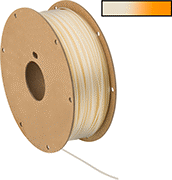
Often used to monitor UV exposure and test UV curing and sterilization equipment, parts made from these filaments change color when exposed to the sun or UV lights. Made from PLA, the most commonly used 3D printing material, they make detailed parts at a low melting point. As a result, they rarely clog nozzles, won’t warp as they cool, and don’t require a heated printer bed. They’re also unlikely to drip and produce plastic strings for a clean finished part. Print them on a fused filament fabrication (FFF) 3D printer.
Tensile strength is the best measure of a filament’s overall strength. Similar to the stress applied on a rope during a game of tug-of-war, it’s the amount of pulling force a material can handle before breaking. A higher rating means a stronger filament. A tensile strength of 5,000 psi and above is considered good; 12,000 psi and above is excellent.
Maximum exposure temperature is the point at which a printed part will begin to deform. Above this temperature, your part will start to lose structural integrity.
Spool | ||||||||||
|---|---|---|---|---|---|---|---|---|---|---|
| Dia., mm | Printing Temp. | For Printer Bed Temp. | Tensile Strength, psi | Max. Exposure Temp. | For Min. Nozzle Dia., mm | Dia., mm | Dp., mm | Wt., g | Each | |
PLA Plastic | ||||||||||
Beige to Orange Indicator | ||||||||||
| 1.75 | 190° to 230° C 374° to 446° F | 25° to 60° C 77° to 140° F | 6,620 (Good) | 58° C 136° F | 0.4 | 200 | 65 | 1,000 | 0000000 | 000000 |
Structural Support 3D Printer Filaments
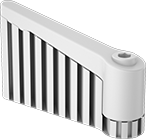
with your part to prevent the
part from losing its shape
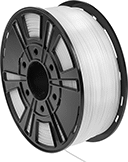
When 3D printing a model with overhangs or hollow spaces, use these filaments to prevent the model from losing its shape. They support the structure during the printing and cooling process, then dissolve or snap away once the part is hardened. Use them in dual-extrusion fused filament fabrication (FFF) printers alongside your primary filament. Unlike parts with supports printed from a single filament, there’s no cutting, sanding, or polishing required.
Choose a filament that has similar printing requirements as your primary filament. You will want to choose a support filament that prints at a similar temperature as your primary filament and has the same requirements for a heated build chamber, so they cool at the same rate and won’t warp. Aquasys GP filaments are good at supporting heat-sensitive materials, such as PLA and PET, because they print well at lower temperatures and don’t need a heated build chamber.
You should also consider how you will remove the structural support filament from your finished part. Soluble filaments are well suited to print parts with complex or fragile designs as they gently dissolve off your primary part, leaving a smooth finish. Water-soluble filaments dissolve in a heated bath.
Spool | ||||||||||||
|---|---|---|---|---|---|---|---|---|---|---|---|---|
| Dia., mm | Printing Temp. | For Printer Bed Temp. | Hardness | Max. Exposure Temp. | Water Temp. to Dissolve | For Min. Nozzle Opening Dia., mm | Dia., mm | Dp., mm | Wt., g | For Use With | Each | |
Water Soluble | ||||||||||||
Aquasys GP—Semi Clear Off-White | ||||||||||||
| 1.75 | 225° to 255° C 437° to 491° F | 40° to 60° C 104° to 140° F | Not Rated | 57° C 134° F | 25° C 77° F | 0.4 | 200 | 55 | 500 | PET Plastic PETG Plastic PLA Plastic | 0000000 | 000000 |
| 2.85 | 225° to 255° C 437° to 491° F | 40° to 60° C 104° to 140° F | Not Rated | 57° C 134° F | 25° C 77° F | 0.4 | 200 | 55 | 500 | PET Plastic PETG Plastic PLA Plastic | 0000000 | 00000 |
Dremel 3D Printer Filaments
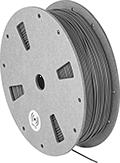
Build parts and prototypes from these filaments using Dremel fused filament fabrication (FFF) 3D printers. An RFID tag on the spool communicates with your printer, automatically adjusting it to the correct temperature and print speed for the filament material and notifying you when the filament is running out.
PLA filaments are the most commonly used in 3D printing. PLA is easy to use; it rarely clogs nozzles, doesn’t require a heated printer bed, and prints at a low temperature—meaning parts won’t warp while cooling. It produces string-free parts, so you can use it to print with a high level of detail. Less durable and more sensitive to heat than ECO-ABS, PLA is better for printing prototypes than end-use parts.
Tensile strength is the best measure of a filament's overall strength. Similar to the stress applied on a rope during a game of tug-of-war, it's the amount of pulling force a material can handle before breaking. A higher rating means a stronger filament. A tensile strength of 5,000 psi and above is considered good; 12,000 psi and above is excellent.
Maximum exposure temperature is the point at which a printed part will begin to deform. Above this temperature, your printed parts will start to lose structural integrity.
MakerBot 3D Printer Filaments
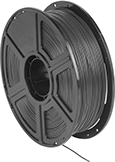
Compatible with the MakerBot Replicator 2 Desktop 3D Printer, all Fifth Generation MakerBot Replicator 3D printers, and Sketch printers. Product regulations restrict sales to the listed jurisdictions/areas.
Spool | |||||||||
|---|---|---|---|---|---|---|---|---|---|
| Material | Color | Dia., mm | Wt. | Manufacturer Model Number | Dia. | Dp. | Cannot Be Sold To | Each | |
For Manufacturer Series: Fifth Generation Replicator, Replicator 2 | |||||||||
| PLA | Black | 1.75 | 900 g | MP05775 | 9 3/4" | 1 1/2" | __ | 0000000 | 000000 |
| PLA | Blue | 1.75 | 900 g | MP05776 | 9 3/4" | 1 1/2" | __ | 0000000 | 00000 |
| PLA | Gray | 1.75 | 900 g | MP05784 | 9 3/4" | 1 1/2" | __ | 0000000 | 00000 |
For Manufacturer Series: Sketch | |||||||||
| PLA | Black | 1.75 | 2.2 lbs. | 375-0048A | 8" | __ | Outside United States and Canada | 0000000 | 00000 |
| PLA | Blue | 1.75 | 2.2 lbs. | 375-0047A | 8" | __ | Outside United States and Canada | 0000000 | 00000 |
| PLA | Gray | 1.75 | 2.2 lbs. | 375-0049A | 8" | __ | Outside United States and Canada | 0000000 | 00000 |
| PLA | White | 1.75 | 2.2 lbs. | 375-0046A | 8" | __ | Outside United States and Canada | 0000000 | 00000 |
Filament 3D Printers
Melt and extrude plastic filaments to build quick and inexpensive prototypes, custom and complex parts, and manufacturing aids such as jigs and fixtures. These 3D printers are also known as fused filament fabrication (FFF) and fused deposition modeling (FDM) printers. They meet U.S. and international standards for safety. Product regulations restrict sales to the listed jurisdictions/areas.
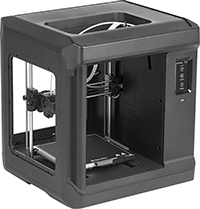

These printers use PLA, which is good for creating prototypes. PLA prints at a low temperature, so it rarely clogs extruders. Because it’s so low maintenance, it’s the most common material for 3D printing. MakerBot printers are compatible only with MakerBot-brand filaments.
These printers have a camera that connects to the internet, so you can stream live video of the printing process to monitor it remotely. They have heated printer beds to prevent parts from warping during cooling.
Max. Printing | Printer Bed | Overall | |||||||||||||||
|---|---|---|---|---|---|---|---|---|---|---|---|---|---|---|---|---|---|
| Lg. | Wd. | Ht. | Min. Layer Ht., mm | Printer Speed, mm/s | Material | Type | Lg. | Wd. | Ht. | Accuracy, mm | Data Connection Type | Current, A | Voltage | Specifications Met | Cannot Be Sold To | Each | |
Sketch Large | |||||||||||||||||
| 8.7" | 7.9" | 9.84" | 0.1 | 150 | Steel | Heated | 18 1/2" | 21.07" | 21.54" | Not Rated | Ethernet, USB-A, Wi-Fi | 2.7 | 120V AC, 240V AC | C-UL Listed, CE Marked, UL-Listed | Outside United States and Canada | 0000000 | 000000000 |
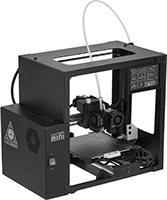
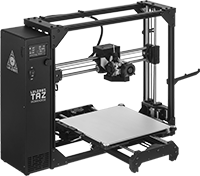
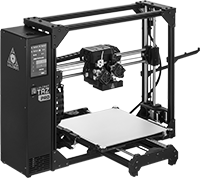
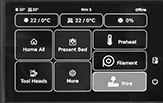

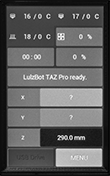
LulzBot printers are compatible with many different materials, so they’re useful across a wide range of applications. They have a minimum layer height that is twice as thin as MakerBot printers, meaning they print a finer level of detail. LulzBot printers come with open source software, so you can manually adjust temperature and print settings. All have heated printer beds to prevent parts from warping during cooling.
Mini 3 printers are the smallest in our offering but also the fastest; use them to quickly print small pieces. They have a magnetic bed which makes it easy to remove delicate prints without breaking them.
The TAZ Workhorse and TAZ Pro printer beds are reversible—prints adhere well to the PEI glass side, while the borosilicate glass side is especially flat for perfectly level prints. The TAZ Workhorse printers have the best combination of size and speed in our offering. The TAZ Pro printers are not as fast as the Mini 3 or the Workhorse, but have dual extruders so you can print structural supports. Dual extruders can also print two different colors into a single part.
Max. Printing | Printer Bed | Overall | ||||||||||||||
|---|---|---|---|---|---|---|---|---|---|---|---|---|---|---|---|---|
| Lg. | Wd. | Ht. | Min. Layer Ht., mm | Printer Speed, mm/s | Material | Type | Lg. | Wd. | Ht. | Accuracy, mm | Data Connection Type | Current, A | Voltage | Specifications Met | Each | |
Mini 3 | ||||||||||||||||
| 7" | 7" | 7" | 0.05 | 500 | PEI Glass | Heated, Magnetic | 18" | 13" | 24" | ±0.2 | USB-A | 3.2 | 120V AC, 240V AC | UL Listed, ETL Listed, C-ETL Listed, OSHW Certified, CSA Certified, CE Marked | 0000000 | 000000000 |
TAZ Workhorse | ||||||||||||||||
| 11" | 11" | 11 1/8" | 0.05 | 300 | Borosilicate Glass PEI Glass | Heated | 32 3/4" | 20" | 20 1/2" | ±0.2 | Standard SD Card, USB-A | 3.2 | 120V AC, 240V AC | UL Listed, ETL Listed, C-ETL Listed, OSHW Certified, CSA Certified, CE Marked | 0000000 | 00000000 |
TAZ Pro | ||||||||||||||||
| 11" | 11" | 11 1/8" | 0.05 | 200 | Borosilicate Glass PEI Glass | Heated | 32 5/8" | 28" | 20 1/2" | ±0.2 | USB-A | 3.2 | 120V AC, 240V AC | UL Listed, ETL Listed, C-ETL Listed, OSHW Certified, CSA Certified, CE Marked | 0000000 | 00000000 |




























